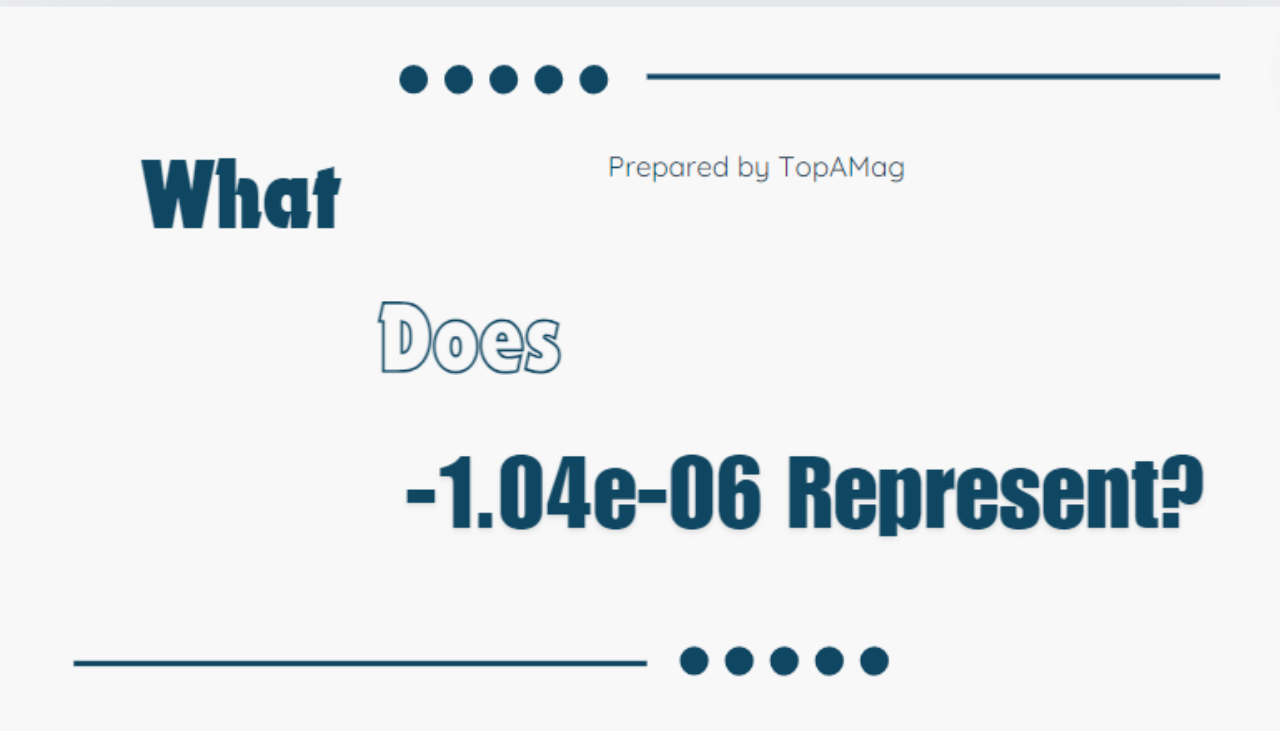In the realm of scientific notation and numerical representation, the notation -1.04e-06 might seem confusing at first glance. However, this format is widely used in scientific and mathematical contexts to express very small or very large numbers in a more manageable way.
In this article by the TopAMag team, we will explore what -1.04e-06 represents, its significance, and its applications in various fields. By the end, you will have a clear understanding of this notation and its practical uses.
Understanding Scientific Notation
Scientific notation represents very large or very small numbers in a more concise and manageable format. We express it as a number between 1 and 10 multiplied by a power of 10. For example, we write the number -1.04e-06 in scientific notation, where “e” stands for exponent. This notation simplifies complex numbers and makes it easier to perform mathematical operations and comparisons.
Breaking Down -1.04e-06
To understand this problem, we need to break down its components:
- -1.04: This is the coefficient or mantissa. It is a decimal number that falls between 1 and 10.
- e-06: This indicates the power of 10 by which the coefficient is multiplied. The -06 signifies that the coefficient is multiplied by 10 and raised to the power of -6.
- In numerical terms, the given quantity is equivalent to -1.04 × 10^(-6). This notation expresses a very small negative number.
Converting -1.04e-06 to Decimal Form
To convert -1.04e-06 into decimal form, we shift the decimal point six places to the left. The calculation is as follows:
- Start with the number -1.04.
- Move the decimal point six places to the left: -0.00000104.
- Thus, the asked quantity is equivalent to -0.00000104 in standard decimal notation. This conversion helps in understanding the magnitude of the number more intuitively.

Practical Applications of -1.04e-06
The representation of the given number is commonly used in various scientific and engineering fields where precision is crucial. Here are some areas where we can apply scientific notation:
1. Physics and Engineering
In physics and engineering, measurements often involve very small quantities. For instance, when dealing with atomic or subatomic particles, or when measuring minute electrical currents, scientific notation like -1.04e-06 is used to represent these small values accurately.
2. Chemistry
Chemists frequently use scientific notation to express concentrations of solutions or quantities of substances. For example, by using scientific values, we might use a concentration value to indicate a very dilute solution in chemical reactions or experiments.
3. Astronomy
In astronomy, distances, and other measurements in space can be extremely large or small. Scientific notation helps in managing these numbers. While the given Number is relatively small, astronomers might use similar notations to deal with various measurements of celestial phenomena.
4. Data Analysis
In fields like data analysis and statistics, scientific notation helps in handling data sets with extremely large or small values. For instance, in analyzing data from sensors or financial models, values expressed in scientific notation streamline calculations and data representation. If you want to learn more skills, you can visit CISD SSO Portal for better education Learning.
Significance of Negative Numbers in Scientific Notation
The negative sign in the number/Quantity indicates that the number is less than zero. Negative numbers are used in scientific notation to represent values below a baseline or reference point. This is important in contexts like electrical charge measurements, temperature variations, and other scenarios where negative values are relevant.
Comparison with Other Scientific Notations
Comparing -1.04e-06 with other scientific notations can provide insight into its scale. For instance:
- -2.00e-04: This is 100 times larger than the asked quantity.
- -1.00e-08: This is 10 times smaller than the quantity.
- Understanding these comparisons helps in visualizing the magnitude of -1.04e-06 relative to other values.
Conclusion
In summary, -1.04e-06 represents a very small negative number in scientific notation, equivalent to -0.00000104 in decimal form. This notation is invaluable in scientific, engineering, chemistry, astronomy, and data analysis contexts, allowing for precise and manageable expression of very small values. By understanding scientific notation, we can better interpret and work with numbers that appear in a wide range of scientific and technical applications.
Understanding and using scientific notation like -1.04e-06 enhances our ability to work with small quantities effectively. Whether you’re a student, a professional in a scientific field, or simply curious about mathematical notation, grasping these concepts is fundamental to comprehending and applying numerical values accurately in various contexts.

